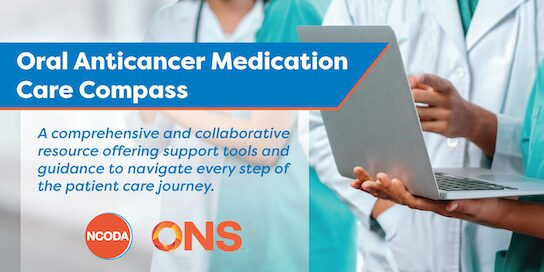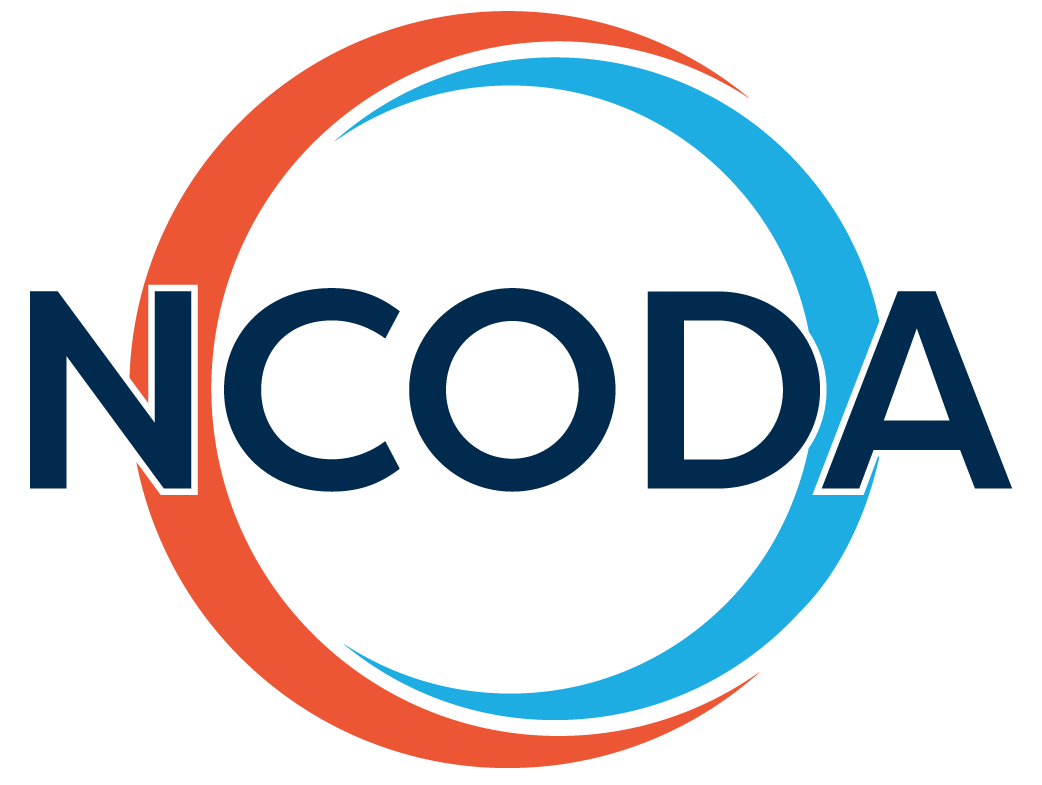2025 Oncology Institute
April 16, 2025 | 2:25 PM EST
Oral Anticancer Medication Care Compass

Resources for Interprofessional Navigation
NCODA is a nonprofit organization dedicated to creating innovative resources that empower medically integrated oncology teams to deliver exceptional care. In alignment with NCODA’s mission to foster collaboration, this resource was developed through a joint effort between:
OPTIMIZING PATIENT CARE
Caring for individuals taking oral anticancer medications (OAMs) presents unique challenges for both patients and healthcare professionals. Successfully navigating these complexities requires a proactive, collaborative approach that bridges gaps in care, and supports patients throughout their cancer treatment journey.
Through an interprofessional effort, ONS and NCODA have developed resources to assist practices in navigating the care of patients taking OAMs. The OAM Care Compass is a comprehensive collection of tools designed to help practices analyze their processes, design effective workflows, enhance patient education, and improve outcomes through standardized, high-quality care.
This Positive Quality Intervention (PQI) resource outlines the steps practices can take to analyze their current workflow and create an interprofessional process that promotes seamless, efficient, and patient-centered care.
Created by an interprofessional team of pharmacists and nurse experts, this tool helps practices assess their current OAM program by highlighting key points for workflow development and recommending expert intervention strategies.
Login
Comprehensive patient education has been identified as an important aspect of care and a key component of an oral anticancer medication (OAM) program. Developed as a collaboration between ONS and NCODA, this resource guide will provide an OAM education checklist and additional tools to support the care of patients taking OAMs.
Login
Oral anticancer medications (OAM) carry a wide array of toxicities. It is critical for healthcare providers to identify and manage therapy-related toxicities early on to keep patients on the treatment as prescribed. Using a standardized toxicity grading tool is helpful for determining a course of action, when dose delays may be needed, and when treatment discontinuation may be necessary
The National Cancer Institute’s Common Toxicity Criteria of Adverse Events (CTCAE) is often used to grade toxicities related to antineoplastic therapy, including OAMs.
See below for a link to this open access resource to use when assessing and grading side effects of cancer treatments.
The CTCAE provides descriptive terminology for commonly experienced adverse events associated with antineoplastic therapy. It is a grading tool that allows for a standardized way of assessing the severity of symptoms and helping clinicians make decisions about care. A link to the most recent version of the tool can be found here.
Common Adverse Events Associated with Oral Therapies
|
Oral Therapies |
Common Adverse Events
|
|
Anaplastic lymphoma kinase (ALK) Inhibitors |
Cardiotoxicity, Diarrhea, Fatigue, Hepatotoxicity, Hypertension, Myelosuppression, Rash
|
|
Cyclin-Dependent Kinase 4/6 (CDK4/6) Inhibitors |
Anemia, Diarrhea, Fatigue, Nausea, Neutropenia, Thrombocytopenia
|
|
Endothelial Growth Factor Receptor (EGFR) Inhibitors |
Conjunctivitis, Mucositis, Skin Rash
|
|
Immunomodulators |
Constipation, Fatigue, Myelosuppression, Neuropathy
|
|
Tyrosine Kinase Inhibitors (TKI) |
Fatigue, Hand-Foot Syndrome/Palmar-Plantar Erythrodysesthesia Syndrome, Hypertension, Nausea, Vomiting
|
Toxicity Grading Case Studies Activity Click HERE
Insurance pharmacy benefit manager (PBM) restrictions often result in OAM prescriptions being dispensed by a different pharmacy than the one where they were initially sent, leading to confusion and treatment delays. Proactive engagement with specialty pharmacies allows clinicians to bridge care gaps and prevent such delays.
Building personal connections within specialty pharmacies is an effective way to minimize OAM acquisition challenges. Collaborating directly with a personal pharmacy contact streamlines the prescription process, enabling clinicians to provide key information such as patient demographics, insurance details, prior authorization status, and case numbers.
Pharmaceutical manufacturers often offer Patient Assistance Programs (PAPs) to provide free medication to underinsured patients. However, approved medications are typically dispensed by a different pharmacy contracted with the PAP program, which can cause confusion during refills or dosage adjustments.
This directory template helps clinicians organize specialty pharmacy contacts and patient assistance program (PAP) details to promote continuity of care, timely treatment initiation, and patient safety.
Login
Currently in development, this resource will summarize the latest data in adherence monitoring and share tools that are used to assess and track adherence in the OAM setting.
ONS Website: ONS Care Compass Website
Link to PEP page – https://www.ons.org/clinical-tools/pep
Podcast Episode – Cancer Symptom Management Basics: Dermatologic
Complications – https://www.ons.org/podcasts/episode-250-cancer-symptom-management-basics-dermatologic-complications
Podcast Episode – Cancer Symptom Management Basics: Cardiovascular Complications https://www.ons.org/podcasts/episode-244-cancer-symptom-management-basics-cardiovascular-complications
CE Webinar: Interprofessional OAM Care Compass CE Webinar coming in May 2025!
NCODA PQI Podcast: Analyzing OAM Workflows and Performing Process Mapping coming soon!
ONS Podcast on Care Compass Resources: Coming soon!

A Community Like No Other
A hallmark of NCODA’s member practices is the camaraderie and support provided across the network. Not only do we support our member practices, but they support one another. Together, we create quality tools and resources that enhance knowledge, streamline workflows, and support the delivery of exceptional patient care.
Become a Member






